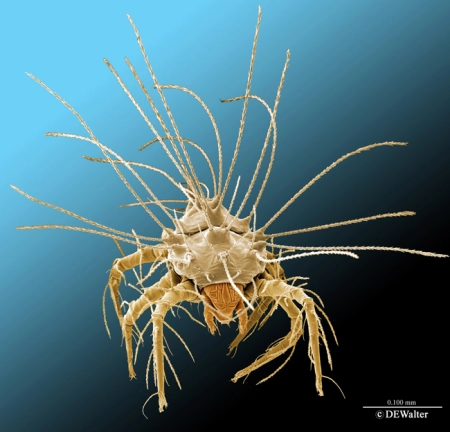The search for the origin of Oribatida has made some significant progress thanks to a number of classicists and oribatologists and after I’ve tracked down one last reference, all will be revealed. In the meanwhile, in a comment on the last post, James Trager pointed out that ” a better translation for Tectoribates would be either thatch roamer or roof roamer (roofs having once been mostly made of thatch)”. This hypothesis is supported by the OED, which gives the origin of words like ‘tectiform’ (=roof-shaped) from the Latin ‘tectum’ (=roof). Additional support comes from Gordon Gordh’s and David Headrick’s excellent A Dictionary of Entomology (ADE, 2001 CABI), who point out that ‘tectiform’ is used to describe insects like cicadas that hold their wings roof-like in repose and also from Donald Borror’s handy Dictionary of Word Roots and Combining Forms (1971, Mayfield Publishing Company) that gives ‘tect-‘ as arising from the Latin and Greek for roof. This raises a number of problems though. First, my Tectoribates species are neither arboreal (so not roof mites) nor from grasslands (so thatch would be misleading), nor is any structural feature like thatch or a sloping roof. Second, acarologists have their own definition: tectum (pl. tecta) – any shelf-like projection of the cuticle.
Acarologists often go their own way on terminology, and this is especially true of oribatologists. As a recently reconverted oribatologist (after a quarter century pursuing other types of mites), my pet peeve with the oribatid jargon is ‘sensillus (pl. sensilli)’ – used for the motion-detecting seta that emerges from a cup-like receptacle on the prodorsum (the spiky, club-like structures on the image above). All the rest of animal morphology uses the neuter form ‘sensillum (pl. sensilla)’ for a sensory seta or other sense organ. ‘Sensillus’ causes no end of confusion and snide comments when a literate, but non-oribatological, referee gets a paper. However, in defence of this non-conformity, it is worth noting that ADE gives ‘sensillum’ as being derived from the Latin ‘sensus’ (=sense), a masculine noun, and so the oribatologists may hold the high ground here.
On further study, this also seems true of ‘tectum’, or at least there is more too it than an A-shaped roof. Cassel’s Latin Dictionary (1968, Wiley) gives ‘tectum’ as the substantive of ‘tego’ the verb ‘to cover’ and exemplars of usage including burying, protection by a shield, and to conceal. The last two would seem to go to the heart of the tecta of oribatid mites: most such structures are designed to shield or cover the legs or other parts of the body where a nasty predator might try to gain a foothold. In the picture above you can see a variety of such tecta including the wing-like pteromorphs that cover the legs, the pedotecta at the base of the legs, the tutoria* (from the Latin to guard or protect) protecting the outer sides of legs I , and the median lamellae (from the Latin for a small plate) covering the tops of legs I. Nature must be very red in others’ teeth and claws for an oribatid mite.
In Tectoribates the lamellae are unusually well developed and I suspect that Antonio Berlese may have been thinking ‘roof-like’ when he coined the genus in 1910. So, I’m going with Roofed Roamers and my thanks to James.
*tutorium, tutoria (not tutor as the spellchecker would have it)


